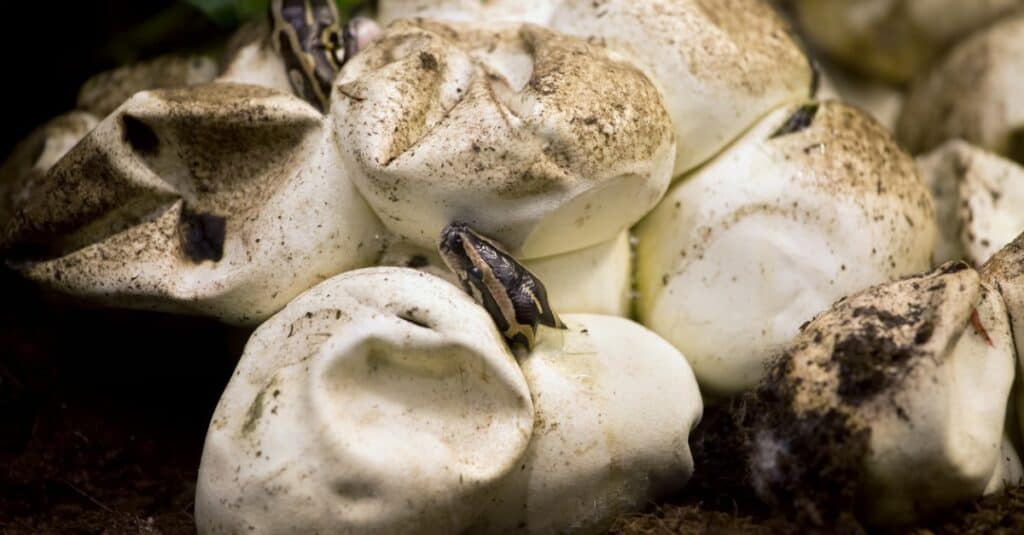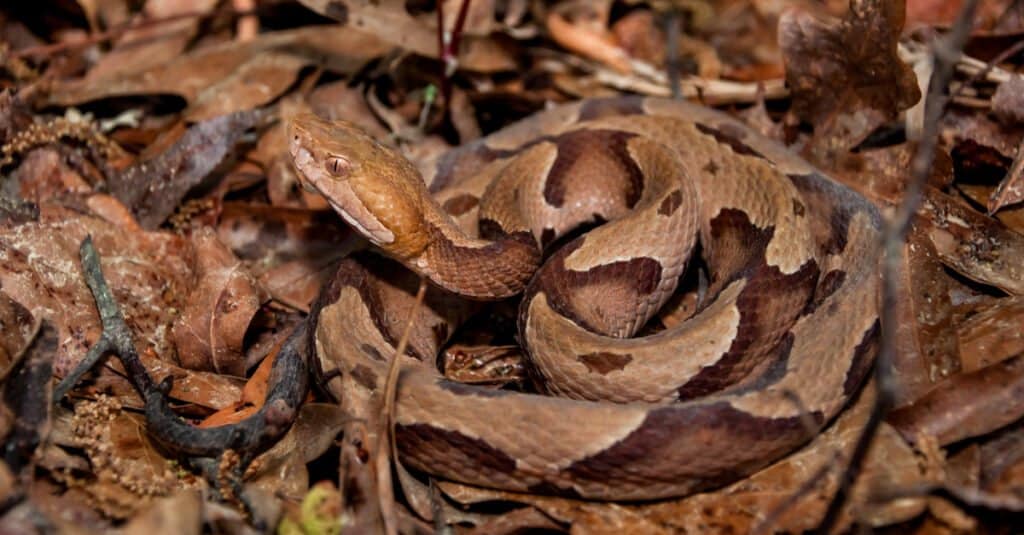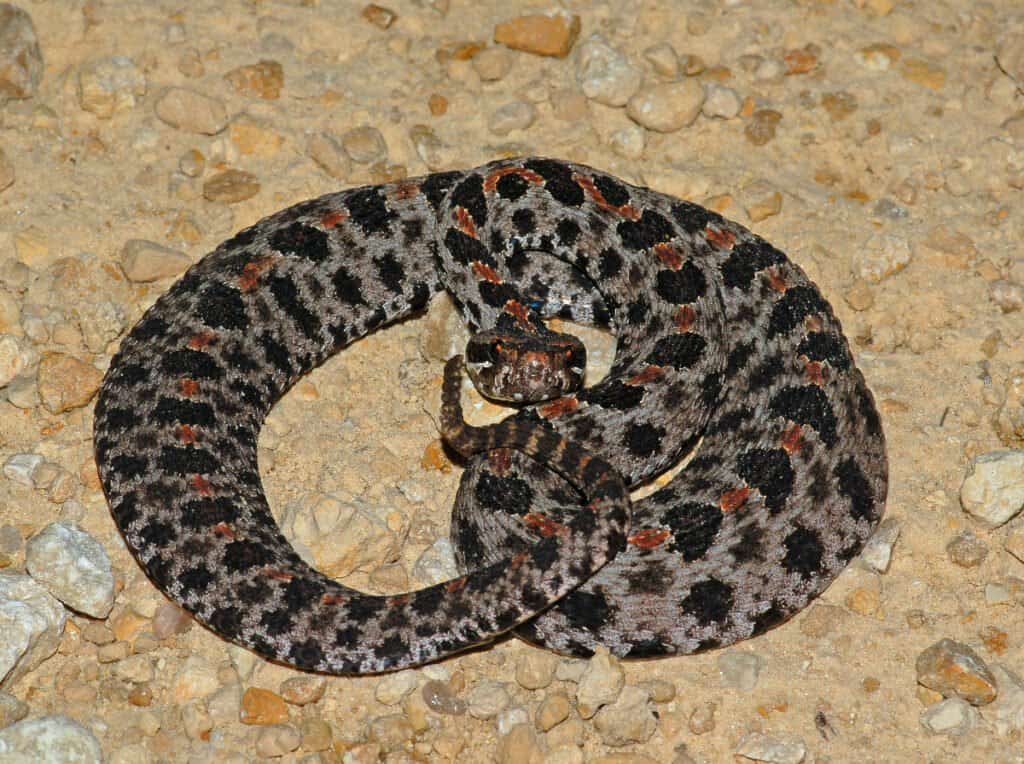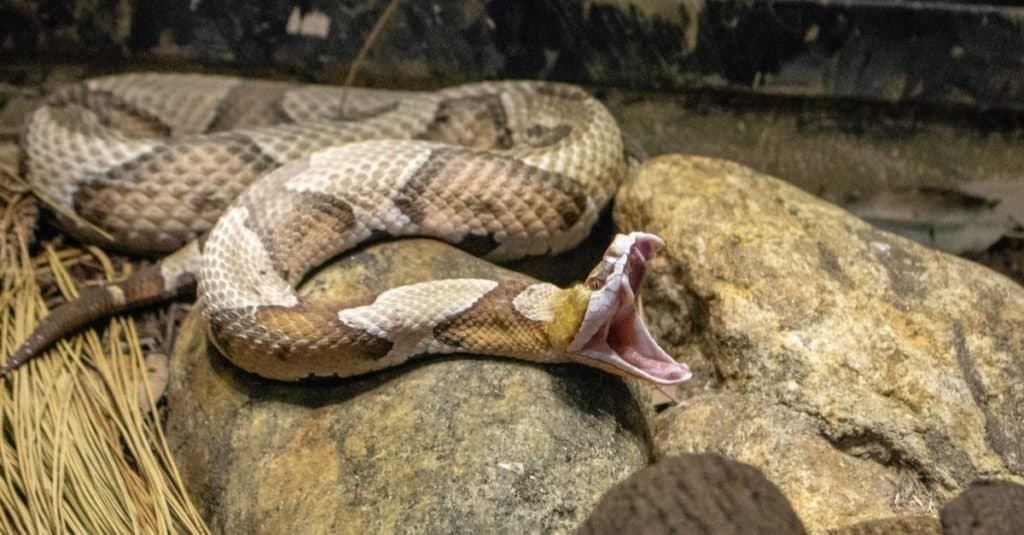When Do Snakes Come Out in Tennessee?
#mobileSnakeQuizControls { overflow: hidden; text-overflow: ellipsis; white-space: nowrap; }
@media (min-width: 481px) {
.mobile-top-content {
display: none;
}
}
#mobileTopContentCTACarouselControls { overflow: hidden; text-overflow: ellipsis; white-space: nowrap; }
.mobile-top-content .more { color: #fff; }
.mobile-top-content a { color: #fff; text-decoration: underline; }
.mobile-top-content a:hover { color: #fff; text-decoration: underline; }
@media (max-width: 480px) {
.mobile-top-content {
background-color: #06a10b;
color: #fff;
text-align: center;
/*height: 60px;
padding-top:5px;*/
font-size:80%;
/* display: block; */
margin: 0px -30px;
}
}

Kevin Ruck/Shutterstock.com
Those who reside in or visit Tennessee should be mindful of the wildlife that inhabits the state. Snakes thrive in Tennessee because of the state’s varied climate and abundance of wooded hillside forests. If you want to avoid an encounter with a snake, read on to learn when they are most active in Tennessee, which ones are poisonous, and how to avoid getting bitten.
Snake Brumation Period In Tennessee
To conserve energy, snakes and other reptiles go into a state termed “brumation.” Unlike hibernation, brumation requires less sleep. They will forage for food and water but may survive extended periods without feeding. A snake may go weeks without eating, drinking, defecating, or moving.
button.pulse {
transform: scale(1); animation: pulse 2s infinite;
box-shadow: 0 0 0 0 rgba(11, 247, 25, 1);
}
@keyframes pulse {
0% { transform: scale(0.90); box-shadow: 0 0 0 0 rgba(11, 247, 25, 0.5); }
60% { transform: scale(1); box-shadow: 0 0 0 15px rgba(11, 247, 25, 0); }
100% { transform: scale(0.90); box-shadow: 0 0 0 0 rgba(11, 247, 25, 0); }
}
Depending on the conditions, a snake’s brumation period might last from September to December. The first thing snakes notice when they leave their den is the temperature change. Snakes hide in caves to stay warm in the wild. Snakes will even share their dens during the winter months to stay warm.
Most Active Periods for Snakes in Tennessee

iStock.com/Artur Bogacki
Peak Seasons
Snakes are most active during the early spring and early summer when they are feeding and breeding. As scorching summer temperatures begin to decrease in late summer and early fall, snake activity increases in Tennessee. Due to the cooler temperatures, numerous snake species become more active throughout the day during the autumn months. Late summer and early fall are baby snake seasons when certain snake clutches (snake eggs) start to hatch.
Time of the Day
Snakes are active both day and night. The season influences when they are most active. For example, snakes typically sleep around sundown during the cooler months and do not reawaken until the morning. During the summer, it might be the opposite.
Snakes To Be On The Lookout For In Tennessee
Snakes are abundant across Tennessee. There are 32 different types of snakes in the state; however only 4 of them are venomous: Northern and Southern Copperheads, Timber Rattlesnakes, Western Cottonmouths, and Western Pygmy Rattlesnakes.
Southern Copperhead

Jay Ondreicka/Shutterstock.com
Copperheads are possibly the most prevalent venomous snake in Tennessee and the surrounding states. They have a triangular skull with elliptical pupils and a pit in their face. The body is pinkish, with deep brown to reddish crossbands. It is pale yellowish to coppery on top and yellowish to coppery on the bottom. Adult tails range in color from black to dark brown. Copperheads average 2–3 feet in length but can reach 4 feet in length.
Timber Rattlesnake

Frode Jacobsen/Shutterstock.com
There are timber rattlesnakes all over the state; they are the state’s largest and most dangerous venomous snake. With vertical pupils and a distinctive rattle at the tail’s end, this enormous, triangular-headed snake can grow to be 3 to 6 feet in length and has vertical eyes and a unique rattle.
Western Cottonmouth

Jay Ondreicka/Shutterstock.com
Cottonmouth snakes, sometimes known as “water moccasins,” are distributed throughout the western part of Tennessee, including counties on the northern edge of the Highland Rim. This snake prefers to be near water, as its name implies. Its skull is triangular, its face is pitted, its pupils are elliptical, and its eyes are smaller. Its body is dark green or deep brown in color and is coated with broad, blackish crossbands. The back of the eye and the tail’s tip are both black. It can range in length from 2.5 to 6 feet.
Western Pygmy Rattlesnake

Gerald A. DeBoer/Shutterstock.com
The Pygmy rattlesnake (affectionately referred to as Pigmy) is Tennessee’s smallest and least-known venomous snake. The Pigmy rattlesnake can be identified by its distinctive midline stripe, which is either orange or rusty in color. Rows of smoky flecks or black crossbars go down the body. Face pits and elliptical pupils embellish the skull. It can reach a maximum length of 31 inches, with an average length of 15 to 22 inches.
Wrapping Up Venomous Snake Bites in Tennessee:

Suzanna Ruby/Shutterstock.com
Even though Tennessee is home to four venomous snakes, snakebite fatalities are uncommon. As with other snakes in the Viperidae family, the timber rattlesnake’s venom is the most toxic to humans. The copperhead is the most common venomous snake.
Despite their unpleasant look, snakes are critical to the ecology of Tennessee. Snake venom is used in medicine, and snakes reduce rodent populations. Additionally, it is critical to keep in mind that a snake, dangerous or not, is not out to harm you. Even venomous snakes pose no danger if you leave them alone and keep an eye on your pets. When trapped or startled, snakes strike.
Snake encounters do not have to result in the snake’s death or injury. If you spot a snake and are unsure of it, return and leave it alone. If it is in your yard or house, vacate the area and contact a specialist.
Discover the “Monster” Snake 5X Bigger than an Anaconda
Every day A-Z Animals sends out some of the most incredible facts in the world from our free newsletter. Want to discover the 10 most beautiful snakes in the world, a “snake island” where you’re never more than 3 feet from danger, or a “monster” snake 5X larger than an anaconda? Then sign up right now and you’ll start receiving our daily newsletter absolutely free.
FAQs (Frequently Asked Questions)
What To Do If You Get Bit by a Snake
DO:
- Keep the snake bite victim calm.
- Allow 15–30 seconds for the bite to bleed before washing.
- Limit movement.
- Get medical care right away.
- Keep the bite location below the heart to decrease venom flow.
- Remove any restricting garments as the area may enlarge.
- Make a loose splint to help limit movement.
- Get rapid evacuation by car, aircraft, or medical staff.
- Look for any signs of shock.
- Only attempt to identify the snake in a safe manner!
DON’T:
- Don’t panic.
- Don’t cut the fang marks and suck the venom out with your mouth.
- Don’t suction.
- Don’t tourniquet.
- Don’t ice the area.
- Don’t give the victim alcohol, caffeine, painkillers, or anything else.
- Don’t try to catch or transport the snake.
- Don’t raise the bite site above the person’s heart.
More from A-Z Animals
.more-snake-card-image { max-height:140px !important; }
#mobileSnakeQuizControls { overflow: hidden; text-overflow: ellipsis; white-space: nowrap; }
@media (min-width: 481px) {
.mobile-top-content {
display: none;
}
}
#mobileTopContentCTACarouselControls { overflow: hidden; text-overflow: ellipsis; white-space: nowrap; }
.mobile-top-content .more { color: #fff; }
.mobile-top-content a { color: #fff; text-decoration: underline; }
.mobile-top-content a:hover { color: #fff; text-decoration: underline; }
@media (max-width: 480px) {
.mobile-top-content {
background-color: #06a10b;
color: #fff;
text-align: center;
/*height: 60px;
padding-top:5px;*/
font-size:80%;
/* display: block; */
margin: 0px -30px;
}
}

Kevin Ruck/Shutterstock.com
Those who reside in or visit Tennessee should be mindful of the wildlife that inhabits the state. Snakes thrive in Tennessee because of the state’s varied climate and abundance of wooded hillside forests. If you want to avoid an encounter with a snake, read on to learn when they are most active in Tennessee, which ones are poisonous, and how to avoid getting bitten.
Snake Brumation Period In Tennessee
To conserve energy, snakes and other reptiles go into a state termed “brumation.” Unlike hibernation, brumation requires less sleep. They will forage for food and water but may survive extended periods without feeding. A snake may go weeks without eating, drinking, defecating, or moving.
button.pulse {
transform: scale(1); animation: pulse 2s infinite;
box-shadow: 0 0 0 0 rgba(11, 247, 25, 1);
}
@keyframes pulse {
0% { transform: scale(0.90); box-shadow: 0 0 0 0 rgba(11, 247, 25, 0.5); }
60% { transform: scale(1); box-shadow: 0 0 0 15px rgba(11, 247, 25, 0); }
100% { transform: scale(0.90); box-shadow: 0 0 0 0 rgba(11, 247, 25, 0); }
}
Depending on the conditions, a snake’s brumation period might last from September to December. The first thing snakes notice when they leave their den is the temperature change. Snakes hide in caves to stay warm in the wild. Snakes will even share their dens during the winter months to stay warm.
Most Active Periods for Snakes in Tennessee

iStock.com/Artur Bogacki
Peak Seasons
Snakes are most active during the early spring and early summer when they are feeding and breeding. As scorching summer temperatures begin to decrease in late summer and early fall, snake activity increases in Tennessee. Due to the cooler temperatures, numerous snake species become more active throughout the day during the autumn months. Late summer and early fall are baby snake seasons when certain snake clutches (snake eggs) start to hatch.
Time of the Day
Snakes are active both day and night. The season influences when they are most active. For example, snakes typically sleep around sundown during the cooler months and do not reawaken until the morning. During the summer, it might be the opposite.
Snakes To Be On The Lookout For In Tennessee
Snakes are abundant across Tennessee. There are 32 different types of snakes in the state; however only 4 of them are venomous: Northern and Southern Copperheads, Timber Rattlesnakes, Western Cottonmouths, and Western Pygmy Rattlesnakes.
Southern Copperhead

Jay Ondreicka/Shutterstock.com
Copperheads are possibly the most prevalent venomous snake in Tennessee and the surrounding states. They have a triangular skull with elliptical pupils and a pit in their face. The body is pinkish, with deep brown to reddish crossbands. It is pale yellowish to coppery on top and yellowish to coppery on the bottom. Adult tails range in color from black to dark brown. Copperheads average 2–3 feet in length but can reach 4 feet in length.
Timber Rattlesnake

Frode Jacobsen/Shutterstock.com
There are timber rattlesnakes all over the state; they are the state’s largest and most dangerous venomous snake. With vertical pupils and a distinctive rattle at the tail’s end, this enormous, triangular-headed snake can grow to be 3 to 6 feet in length and has vertical eyes and a unique rattle.
Western Cottonmouth

Jay Ondreicka/Shutterstock.com
Cottonmouth snakes, sometimes known as “water moccasins,” are distributed throughout the western part of Tennessee, including counties on the northern edge of the Highland Rim. This snake prefers to be near water, as its name implies. Its skull is triangular, its face is pitted, its pupils are elliptical, and its eyes are smaller. Its body is dark green or deep brown in color and is coated with broad, blackish crossbands. The back of the eye and the tail’s tip are both black. It can range in length from 2.5 to 6 feet.
Western Pygmy Rattlesnake

Gerald A. DeBoer/Shutterstock.com
The Pygmy rattlesnake (affectionately referred to as Pigmy) is Tennessee’s smallest and least-known venomous snake. The Pigmy rattlesnake can be identified by its distinctive midline stripe, which is either orange or rusty in color. Rows of smoky flecks or black crossbars go down the body. Face pits and elliptical pupils embellish the skull. It can reach a maximum length of 31 inches, with an average length of 15 to 22 inches.
Wrapping Up Venomous Snake Bites in Tennessee:

Suzanna Ruby/Shutterstock.com
Even though Tennessee is home to four venomous snakes, snakebite fatalities are uncommon. As with other snakes in the Viperidae family, the timber rattlesnake’s venom is the most toxic to humans. The copperhead is the most common venomous snake.
Despite their unpleasant look, snakes are critical to the ecology of Tennessee. Snake venom is used in medicine, and snakes reduce rodent populations. Additionally, it is critical to keep in mind that a snake, dangerous or not, is not out to harm you. Even venomous snakes pose no danger if you leave them alone and keep an eye on your pets. When trapped or startled, snakes strike.
Snake encounters do not have to result in the snake’s death or injury. If you spot a snake and are unsure of it, return and leave it alone. If it is in your yard or house, vacate the area and contact a specialist.
Discover the “Monster” Snake 5X Bigger than an Anaconda
Every day A-Z Animals sends out some of the most incredible facts in the world from our free newsletter. Want to discover the 10 most beautiful snakes in the world, a “snake island” where you’re never more than 3 feet from danger, or a “monster” snake 5X larger than an anaconda? Then sign up right now and you’ll start receiving our daily newsletter absolutely free.







